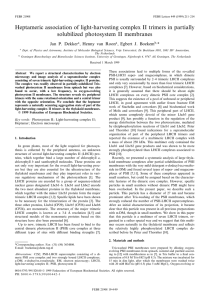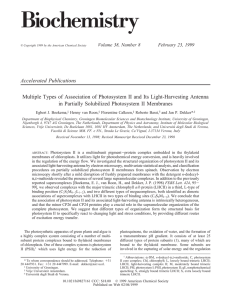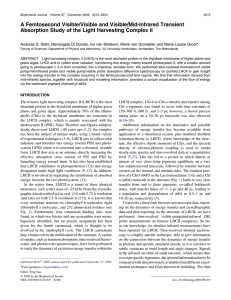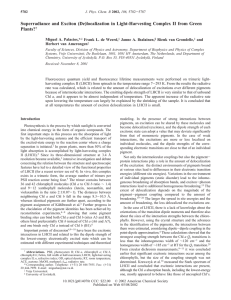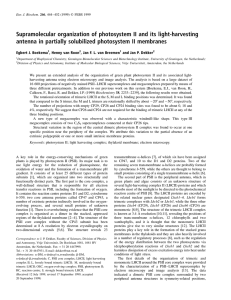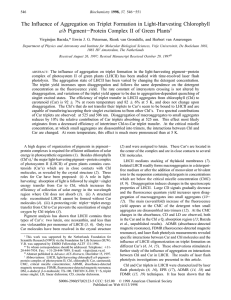Energy Transfer in Photosynthesis
advertisement
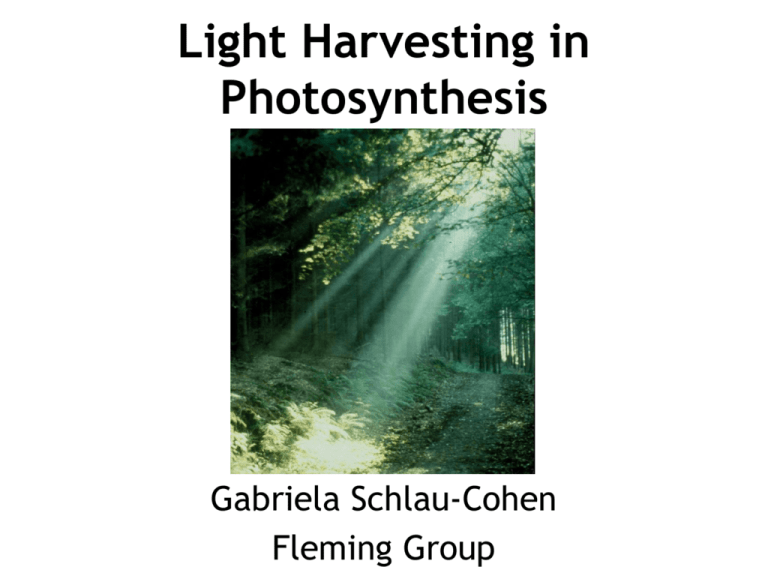
Light Harvesting in Photosynthesis Gabriela Schlau-Cohen Fleming Group Earth is formed Life emerges Photosynthesis Cyanobacteria Oxygen-rich atmosphere Plants Dinosaurs Hominids, 3pm Homo Sapiens, 11:38 pm US 11:59:58 pm Age of Earth 4.55 billion yrs Prevalence of Photosynthesis Photosynthesis 101 6CO2 6H2O light Efficient: ~90% of energy absorbed is used to initiate photochemistry Fast: Turnover rate of photosynthesis : ~ 100-300/sec Regulated: ~75% of absorbed energy can be dissipated with a 1sec response time C6 H12O6 6O2 Architecture of Photosynthesis is Optimized to: Cover the solar spectrum Protect against photochemical damage Separate energy and electron transfer Transmit excitation to the reaction center with near unit efficiency Regulate the efficiency of light harvesting and repair damage (PSII) Protein Complexes in the Plant Pigment Protein Complexes Thylakoid membrane Cross-section of the leaf Chloroplast Overview of photosynthetic LHCII supercomplex CP26 CP43 in plants D1 LHCII Core Complex CP29 CP24 CP47 D2 D2 Core Complex Peripheral antennas CP47 D1 CP24 CP43 CP29 CP26 LHCII LHCII Peripheral antennas Light Harvesting Complex II (LHCII) • >50% of plant chlorophylls in LHCII • Functions as antenna complex • Absorbs light energy and funnels to reaction center How does Light Harvesting Really Work? Can we find a way to image Functionality? • Are the excited states localized? • Are the states optimized in both spatial and energetic landscapes? • Does the excitation hop? • Does Quantum Mechanics matter? • Do only optically allowed transitions matter? • How is photo-induced damage minimized? • How do we learn about interactions, pathways and mechanisms when all the molecules are chemically identical? Spectral Properties of LHCII • Delocalized excited states allow for energetic jumps Chl a Chl b Carotenoids Chl b Vibronic band • Chl b localized near Chl a to allow for downhill energy transfer Two-Dimensional Spectroscopy • Diagonal peaks are linear absorption • Cross peaks are coupling and energy transfer ωt (“emission”) • Excitation at one wavelength influences emission at other wavelengths Dimer Model (Theory) Excited State Absorption Homogeneous Linewidth Cross Peak Inhomogeneous Linewidth ωτ (“absorption”) Dynamics in 2D Spectroscopy Dimer Model (Theory) T=500 fs T=50 ps ωt (cm-1) T=0 fs ωτ (cm-1) ωτ (cm-1) ωτ (cm-1) Experimental Conditions • Sample Details – Wild type LHCII – Extracted from Arabidopsis Thaliana • Sample Conditions – 65:35 v/v glycerol to LHCII solution – LHCII Solution: • 10 mM Hepes/HCl pH 7.6 • OD670=0.18 – Temperature: 77K – 200 um Silanized quartz cell (SigmaCote) • Laser Conditions – 650 nm spectral center, 80 nm FWHM – 23 fs pulse (measured by auto-correlation) – 99.7 μW incident on sample LHCII 2D Spectra LHCII 2D Spectra LHCII 2D Spectra LHCII 2D Spectra LHCII 2D Spectra LHCII 2D Spectra LHCII 2D Spectra LHCII 2D Spectra LHCII Spectral Dynamics Energy Transfer in LHCII Electronic Coupling E E JJ e1 e1 e2 D e2 g1 g2 1 Dimer 2 Localization of Dynamics Electronic Coherence T = 80 fs T = 80 fs Conclusions & Future Directions • Coupling creates delocalized excited states over multiple chromophores • Delocalization means spatial overlap of energetically separate chromophores which allows large energetic jumps • Chl-b arranged near Chl-a for interband energy transfer • What specific mechanisms give rise to these energy transfer processes? • What role does quantum coherence play and how does it change at room temperature? Acknowledgements Graham Fleming Tessa Calhoun Elizabeth Read Greg Engel Naomi Ginsberg References: Rick Trebino, Georgia Tech http://www.physics.gatech.edu/gcuo/UltrafastOptics/index.html Blankenship, R.E. Molecular Mechanisms of Photosynthesis, 2004.


